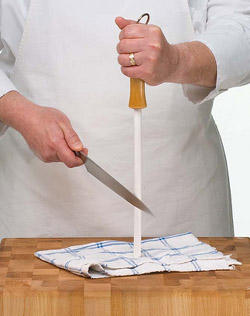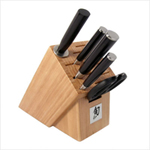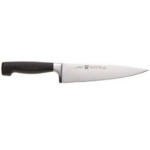Knife Sharpening Tools and Tips

Sharpening your special kitchen knives when it’s required will keep them cutting and slicing away with speed and precision. Even though many knife manufacturers boast that their knives stay sharp and rarely need honing, it’s still smart to have a couple tools at hand for when your blades inevitably start getting dull.
Remember, sharpening knives isn’t just for keeping them in peak condition; it’s also a matter of safety. A dull knife is more likely to slip and cut you than a razor-thin blade.
Whetstone
A whetstone is a great tool for sharpening knives because it doesn’t wear away too much of the blade. The task is fairly straightforward and takes only a couple minutes.
- Position the whetstone on the cutting board, scratchy side up.
- Hold the knife’s edge against the whetstone at a 22 ½ degree angle and slide it forward against the stone, covering all parts of the edge.
- Repeat this movement 10 times, and then flip the knife over to do the other side 10 times.
- Flip the whetstone over so the finer side is facing up. Repeat the previous steps.
The whetstone works away parts of the blade’s edge to get it sharp again. However, the process leaves the edge rough and uneven. After whetting the knife, you’ll need to use the knife sharpener to get the blade’s edge smooth again.
Sharpening Steel
A steel smooths, or hones, the knife’s edge to a straight line, close to the way you originally had it. The steel should be at least as long as the knife you’re sharpening.
- With your non-dominant hand, hold the steel up with the point resting against the cutting board, your hand at the top of the steel.
- Position the knife perpendicular to the steel, with the back of the blade (the part closest to the handle) against the steel. Once again, the knife should be angled 22 ½ degrees against the steel.
- In one fluid motion, simultaneously pull the knife back toward you and down the length of the steel. This motion should cover the entire edge of the blade.
- Do this stroke 10 times, and then turn the knife over and give that side 10 strokes.
After whetting and honing the knife, carefully rinse any miniscule metal filings off the blade and dry it with a cloth. These simple steps will preserve the fine quality and angle of your knife’s edge. Whatever you do, avoid rinky-dink electric sharpeners, which can seriously damage the fine craftsmanship of the blade.
As you get used to the sharpening process, you’ll notice the difference between a sharp and dull blade right away. Some chefs sharpen their knives frequently—at least once a week. You’ll appreciate your whetstone and steel when you see how smoothly your knife cuts through tomatoes, cheese, and carrots.
 |
Brittany Rowland researches new developments in Appliances, Kitchen and CE products features with a vigor to which few would aspire… but someone has to do it. See more about Brittany |
Related Top 10 Lists
Top 10 Knife Sets

Knife sets can be a convenient solution if you want a complete set of all the essential tools but you don’t want to spend a fortune on each individual knife. Value was one of the key considerations we had when choosing the top 10 knife sets. Other factors included:…. [more]
Top 10 Santoku Knives

The finest quality santoku knives are guaranteed to last you many years and provide versatile function in the kitchen. The word santoku means “three virtues,” after all. We looked for a variety of factors as we selected our top 10 knives, including: 1. Durable, strong forged steel, 2. A full tang for extra strength…. [more]
Top 10 Chef’s Knives

The finest quality chefs knives are guaranteed to last you many years and provide versatile function in the kitchen. We looked for a variety of factors as we selected our top 10 knives, including:1. Durable, strong forged steel, 2. A full tang for extra strength…. [more]
Filed Under: Kitchen • Knife Sets






















